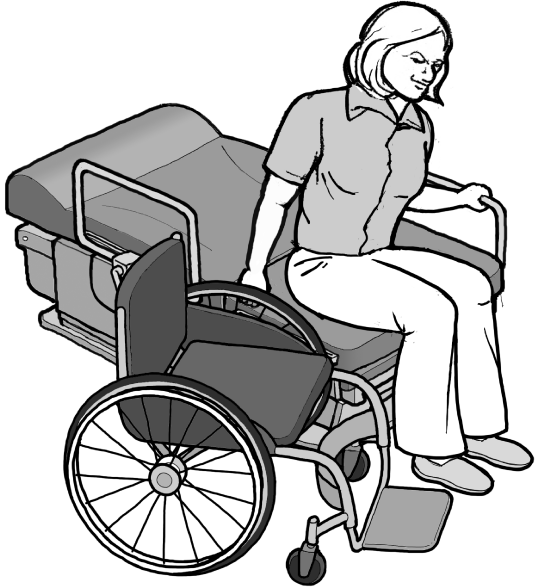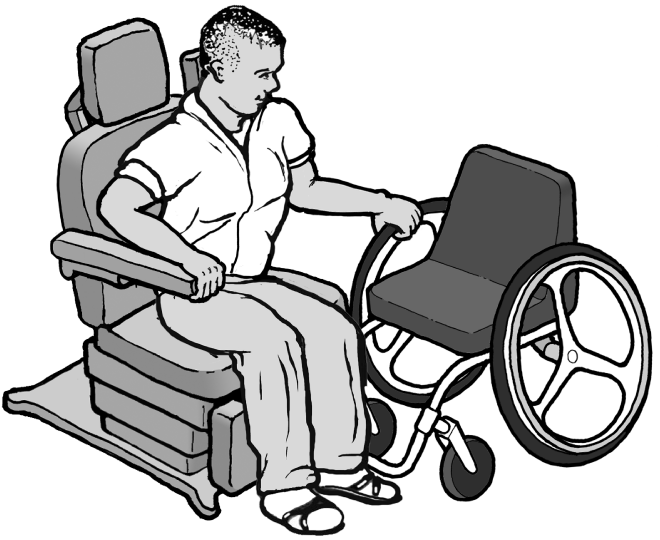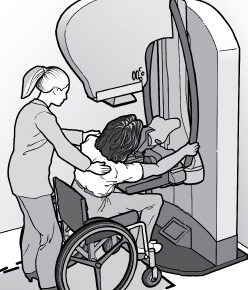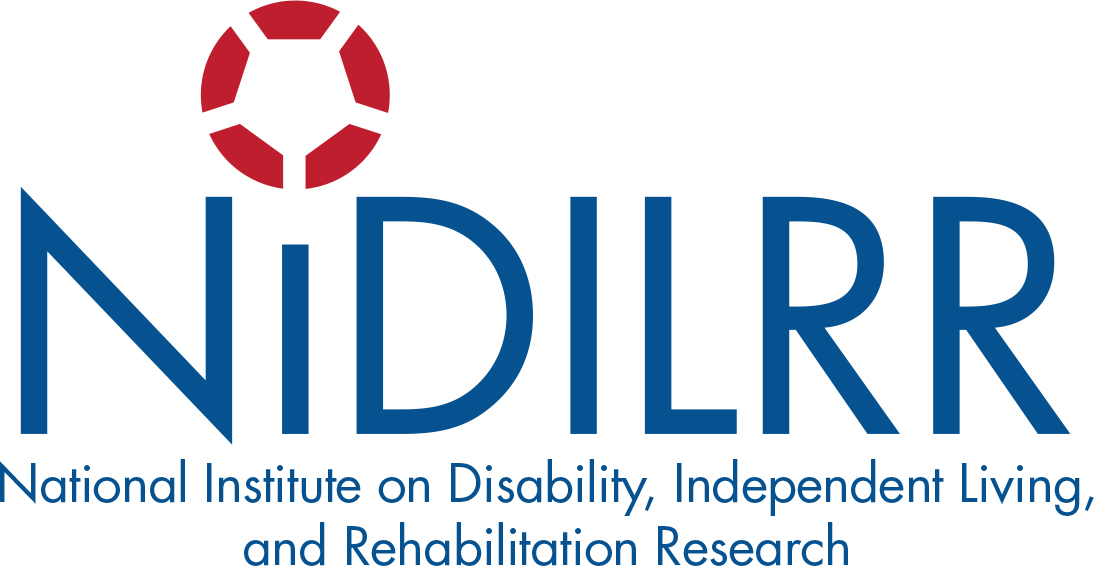 Print-Friendly PDF | Large-Print PDF
Print-Friendly PDF | Large-Print PDF
Affordable Care Act and Section 510 of the Rehabilitation Act
The “Patient Protection and Affordable Care Act” (ACA) added an amendment to Section 510 of the Rehabilitation Act which authorized the U.S. Access Board to develop accessibility standards for medical diagnostic equipment (MDE) in consultation with the Food and Drug Administration. The standards address independent access to, and use of, equipment by people with disabilities to the maximum extent possible. Section 510 describes "medical diagnostic equipment" as equipment that is “used by health care professionals in medical settings, such as physician's offices, clinics, emergency rooms, and hospitals, for diagnostic purposes.” The proposed standards for MDE apply to equipment that includes examination tables, examination chairs (including chairs used for eye examinations or procedures, and dental examinations or procedures), weight scales, mammography equipment, x-ray machines, and other radiological equipment commonly used for diagnostic purposes by health professionals.
 Department of Justice, the ADA and Section 504 of the Rehabilitation Act
Department of Justice, the ADA and Section 504 of the Rehabilitation Act
The Americans with Disabilities Act (ADA) and Section 504 of the Rehabilitation Act require that health care providers provide individuals with disabilities full and equal access to their health care services and facilities. The Department of Justice and the Department of Health and Human Services recently published a guidance document for health care providers regarding their responsibilities to make their services and facilities accessible to individuals with mobility disabilities. See Access to Medical Care for Individuals with Mobility Disabilities in Resources. This guidance document includes information on accessible examination rooms and the clear floor space needed adjacent to medical equipment for individuals who use mobility devices to approach the equipment for transfer; accessible medical equipment (e.g., examination tables and chairs, mammography equipment, weight scales); patient lifts and other methods for transferring individuals from their mobility devices to medical equipment; and training health care personnel.
Evidence of Physical Accessibility Barriers
A number of research publications and federal reports document physical access barriers involving Medical Diagnostic Equipment. Specifically, group and individual interview studies give voice to the experiences of persons with disabilities, offering insights into their often-shared experiences of physical access barriers involving medical equipment in both diagnosis and treatment settings. A brief discussion and list of publications can be found in the Background Chapter of the U.S. Access Board – Advisory Committee Report, Section 2.2 Evidence of Physical Accessibility Barriers. See Resources.
Proposed Standards for Accessible Medical Diagnostic Equipment
 Section 510 does not authorize the Access Board to issue scoping provisions for MDE which specify the minimum number of accessible features to be provided in facilities. Also, it does not address who is required to follow the regulatory standards. The proposed standards establish minimum technical criteria that will allow patients with disabilities independent entry to, use of, and exit from medical diagnostic equipment to the maximum extent possible. For example, sections M301 and M302 of the proposed standards address design and operational features that will allow a patient with a disability to independently transfer onto examination chairs and tables. These proposed standards are not yet enforceable as federal regulations. Refer to the Proposed Standards for Accessible Medical Diagnostic Equipment (see Resources). The proposed standards are based in part on the technical criteria for accessible elements found in the 2004 ADA and ABA Accessibility Guidelines. Other sources of information used in the development of the proposed standards include chapter 16 “Accessibility Considerations” of ANSI/AAMI HE75 Human factors engineering – Design of medical devices, anthropometric data and other standards which address such features as the width of transfer surfaces on diagnostic equipment used by patients in a seated position.
Section 510 does not authorize the Access Board to issue scoping provisions for MDE which specify the minimum number of accessible features to be provided in facilities. Also, it does not address who is required to follow the regulatory standards. The proposed standards establish minimum technical criteria that will allow patients with disabilities independent entry to, use of, and exit from medical diagnostic equipment to the maximum extent possible. For example, sections M301 and M302 of the proposed standards address design and operational features that will allow a patient with a disability to independently transfer onto examination chairs and tables. These proposed standards are not yet enforceable as federal regulations. Refer to the Proposed Standards for Accessible Medical Diagnostic Equipment (see Resources). The proposed standards are based in part on the technical criteria for accessible elements found in the 2004 ADA and ABA Accessibility Guidelines. Other sources of information used in the development of the proposed standards include chapter 16 “Accessibility Considerations” of ANSI/AAMI HE75 Human factors engineering – Design of medical devices, anthropometric data and other standards which address such features as the width of transfer surfaces on diagnostic equipment used by patients in a seated position.
Technical Criteria
 Chapter M3 of the Proposed Standards provides technical criteria for accessible diagnostic equipment based on the patient positions that the equipment is designed to support, including equipment used by patients in a supine, prone, or side-lying position (section M301); equipment used in a seated position (section M302); equipment used while seated in a wheelchair (section M303); and equipment used in a standing position (section M304). Chapter M3 also include technical criteria for equipment supports (section M305), for instructions or other information communicated to patients through the equipment (section M306), and for operable parts used by patients (section M307). Where equipment is designed to support more than one patient position, the equipment would have to meet the technical criteria for each position supported.
Chapter M3 of the Proposed Standards provides technical criteria for accessible diagnostic equipment based on the patient positions that the equipment is designed to support, including equipment used by patients in a supine, prone, or side-lying position (section M301); equipment used in a seated position (section M302); equipment used while seated in a wheelchair (section M303); and equipment used in a standing position (section M304). Chapter M3 also include technical criteria for equipment supports (section M305), for instructions or other information communicated to patients through the equipment (section M306), and for operable parts used by patients (section M307). Where equipment is designed to support more than one patient position, the equipment would have to meet the technical criteria for each position supported.
Equipment Features Needed for Patient Support in Supine, Prone, or Side-Lying,
Seated, Seated in Wheelchair or Standing Positions
|
Patient Positions Equipment Designed to Support |
Equipment Features Addressed by the Technical Criteria M301 or M302 |
Illustrative Examples of Types of Equipment |
|
M301 - Diagnostic Equipment Used by Patients in Supine, Prone, or Side-Lying Position |
· Transfer surface, including height, size, and transfer sides · Transfer supports, stirrups, and head and back support · Lift compatibility |
· Examination tables · Examination chairs designed to recline and be used as examination tables |
|
M302 - Diagnostic Equipment Used by Patients in a Seated Position |
· Transfer surface, including height, size, and transfer sides · Transfer supports, armrests, and head and back support · Lift compatibility |
· Examination chairs · Imaging equipment designed for use with a seat · Weight scales designed for use with a seat |
| M303 - Seated in a wheelchair |
· Wheelchair space, including orientation, width, depth, knee and toe clearance, and surface slope ·Changes in level at entry to wheelchair space, including ramps ·Components capable of examining body parts of patients seated in a wheelchair, including height of breast platforms |
·Imaging equipment designed for wheelchair use ·Weight scales designed for wheelchair use |
| M304 - Standing position |
·Slip resistant standing surface ·Standing supports |
·Imaging equipment designed for use in standing position ·Weight scales designed for use in standing position |
Resources
1. U.S. Access Board – Health Care: http://www.access-board.gov/guidelines-and-standards/health-care
2. U.S. Department of Justice - Access to Medical Care for Individuals With Mobility Disabilities: http://www.ada.gov/medcare_ta.htm
3. Proposed Standards for Accessible Medical Diagnostic Equipment: http://www.access-board.gov/guidelines-and-standards/health-care/about-this-rulemaking/proposed-standards/text-of-the-proposed-standards
4. Example Applications of Proposed Standards: http://www.access-board.gov/guidelines-and-standards/health-care/about-this-rulemaking/background/example-applications-of-proposed-standards
5. The Barrier Free Healthcare Initiative: http://www.ada.gov/usao-agreements.htm
 The Northwest ADA Center is a member of the ADA National Network. This fact sheet was developed under grant from the Administration for Community Living (ACL), NIDILRR grant #90DP0016-02-00. However, the contents do not necessarily represent the policy of the ACL, and you should not assume endorsement by the federal government.
The Northwest ADA Center is a member of the ADA National Network. This fact sheet was developed under grant from the Administration for Community Living (ACL), NIDILRR grant #90DP0016-02-00. However, the contents do not necessarily represent the policy of the ACL, and you should not assume endorsement by the federal government.
